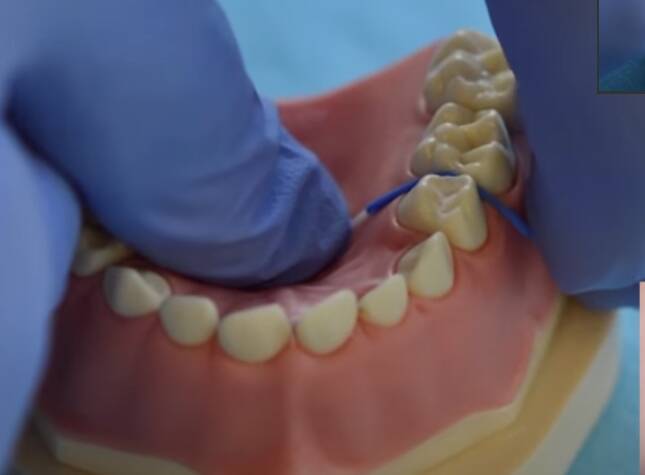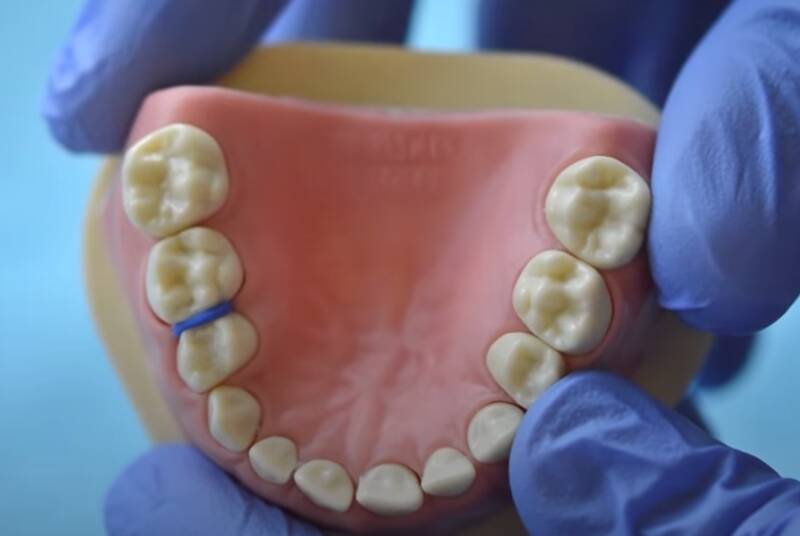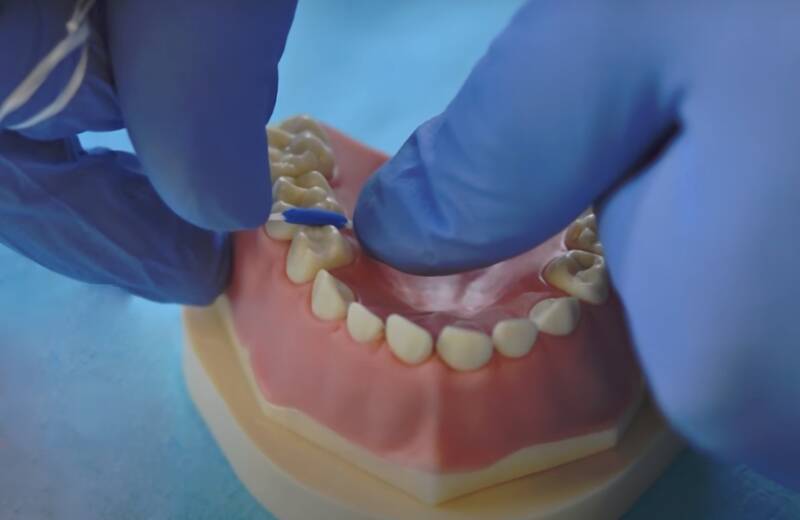Orthodontic separators are small blue plastic rings that are placed between two teeth to gradually move them apart.
Their purpose is to make room for the rings to fit properly and painlessly at the next session.
Pressure may be felt for a short time, but it dissipates within a few days. Chewing gum and caramels are examples of sticky foods to avoid.
You should continue to clean and floss your teeth regularly except where there are orthodontic separators.
I. Do orthodontists still use spacers?
Not all patients need orthodontic spacers, but some have teeth that are so tight that they need them to fit the bands properly.
The purpose of this procedure is to prepare the teeth to receive the braces and to significantly accelerate the dental alignment.
Indeed, some teeth are so tight that it is impossible to put the rings around them. Especially the molars which are usually crowded.
II. Can I bite down on my spacers?
It is recommended not to chew too much with teeth that have received orthodontic spacers. Dentists generally advise not to eat very hard stuff during this period.
Also, use the other side of the jaw if you have had the spacers put in on only one side.
III. How do you brush your teeth with spacers?
Since in most cases orthodontic spacers are only placed on the back teeth, brushing your teeth can be done as usual.
In order not to risk the displacement of the separators from their original positions, it is advisable to brush the teeth horizontally, but not from top to bottom.
The horizontal back-and-forth movement of the toothbrush does not affect its position. However, the toothbrush can make them move if its movement is up and down.
IV. Do teeth stay straight forever after Separators?
Unfortunately, in some cases, teeth may have a natural movement back to their original position even after having braces.
This is why you should have regular follow-ups with your orthodontist even after removing the separators.
And even after removing aligners, your dentist can suggest certain discreet appliances that can keep the teeth in their place until the final stabilization.

V. How do I place an orthodontic separator?
The ring of an aligner should completely cover the tooth, but sometimes insertion is difficult because the dances are all tight together.
In this case, we prefer to precede the session with a break of orthodontic separators.
An elastic separator is inserted with pliers.
We start by applying light pressure between the teeth with our fingertips until we feel that we have crossed the contact point.
It is then in this pressed moment that we insert the elastic already stretched by the pliers.
Three things can happen then.
Either the elastic separator falls off by itself. In this case, the teeth are sufficiently spaced for the next appointment. The orthodontist will then proceed with the placement of the aligner brackets without difficulty.
In the second case, the patient comes to the dental office with the dividers still in his mouth. The dentist will remove them if he or she judges that the teeth are far enough apart to proceed with the placement of the braces.
In the third case, the rubber band may have sunk into the gums. Either you can’t see it anymore or you can only see part of it. In this case, it is better to use a clean pair of tweezers to remove it yourself before the dentist’s appointment.
And in case of force majeure or you can’t go to the dentist’s appointment, you can remove them yourself with tweezers.
VI. What to eat when you have orthodontic dividers in your mouth?
Orthodontists generally advise people with orthodontic separators to avoid certain types of foods.
These foods usually include hard or sticky foods such as candy, gum, and foods that require a lot of chewing, such as steak.
Examples of candy to avoid include butterscotch, fudge, and gummy bears. Chewing gum should also be avoided as it can damage rubber bands.
Finally, foods that require careful chewing, such as steak, can also be detrimental to spacers, as they can cause the wire to loosen or even break.
VII. Do spacers hurt more than braces?
It is important to know that an orthodontic separator exerts a physical force on the teeth and in turn on the roots of the teeth, which are known to be attached to very sensitive nerves.
It is not surprising to feel a little pain in the area of the gum where the separators have been placed.
The pressure of the separators on the teeth is much less than that of a dental aligner, which affects practically all the teeth.
It is easy to guess that in most cases aligners produce more pain than separators. But what is encouraging is that the mouth gets used to this kind of appliance easily and quickly and the pain disappears more quickly after a while when it has been well placed.
If the pain remains significant, it is best to call your dentist to see if the braces have been loosened or tightened very hard on the teeth.
VIII. Do teeth stay after braces?
Teeth can move naturally due to a variety of factors, but this is often due to the pressure they are under daily.
The simple act of speaking and pushing the tongue against the teeth to make certain sounds, chewing, smiling, coughing or sneezing can, over time, cause changes in tooth alignment.
After orthodontics of any kind: braces, Invisalign, or lingual, we know that teeth will move because the mouth is not yet completely stabilized.
Newly displaced teeth always tend to return to their previous position.
Today the solution is simple, orthodontic treatment must always end with dental restraints.
To prevent teeth from shifting, the dentist always places restraints in all orthodontic treatments, starting from the day the brackets are removed or Invisalign is completed.

IX. Types of orthodontic separators:
1. Rubber spacers
These are the most common and most used by orthodontists. They are small elastic rings of varying thicknesses, made of polyurethane.
And they are placed around the interproximal contact point between two adjacent teeth. They are of two types: rounded and sharp.
And finally, they are grasped with separator forceps, stretched, and placed interproximally to separate the teeth.
Elastic ring separators fit perfectly in the interdental area and are the most comfortable for the patient.
2. Metal separators (spacers)
These are small metal rings that are inserted between two posterior teeth. They can be of several types:
# Kesling Spacer
The Kesling Metal Ring Spacer is a spring made of 0.016 round wire. It is grasped with forceps and positioned so that the spiral portion of the spacer is on the buccal side.
Kesling spacers create interdental space more quickly than other types of spacers and are easily tolerated by the patient. However, they can come loose and damage tissue.
# “C” Separator
These are pre-formed brass wire spacers in the shape of a “C”. They are placed around the contact areas of the posterior teeth to maintain space before the band is placed.
The type of spacer used by each orthodontist will depend on the specific case and treatment style of that professional.
Rubber spacers are used in most orthodontic cases.

